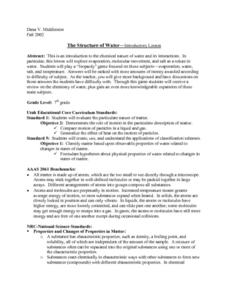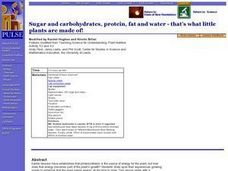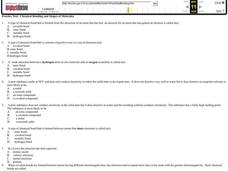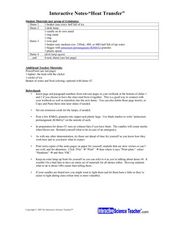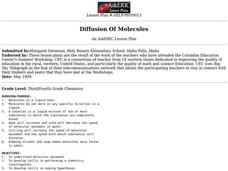Curated OER
Properties of Metals
Fifth graders study the properties of metals and use them to identify different properties. In this metal properties instructional activity students complete a demonstration .
Curated OER
Putting the Ice in Hockey
Eighth grade physical science classes examine why the ice on which hockey is played is slippery. They do so by discussing phases of matter and the molecular motion in each. They read an article on a website and write out answers to 10...
Curated OER
The Chemical Nature of Water
Seventh graders simulate a Jeopardy game to examine the chemical nature of water. Among the topics featured are evaporation, water, salt, and temperature. finally, as review, 7th graders answer a battery of questions presented by the...
Curated OER
Sugar and carbohydrates, protein, fat and water - that's what little plants are made of!
Students identify photosynthesis as the mechanism by which plants convert sunlight energy into a usable energy source for plant processes. They identify photosynthesis as the mechanism by which plants create a molecule that can be used...
Curated OER
Chemical Bonding and Shapes of Molecules
In this chemical bonding learning exercise, students review the different types of bonds and calculate the number of valence electrons in molecules. This learning exercise has 11 matching and 15 multiple choice questions.
Curated OER
Testing the Waters
Students use test kits to measure the level of chlorine, iron, sulfide, and dissolved oxygen in tap (drinking) water and stream water. They post and evaluate the results of these water quality tests.
Biology Junction
Biochemistry of Cells
Chemistry and biology work hand in hand, without one you literally wouldn't have the other. Using a presentation, individuals learn about plant cells, animal cells, cell responses, macromolecules, DNA bases, and so much more. A worksheet...
Serendip
Where Does a Plant's Mass Come From?
Where does the mass for a growing tree come from? Scholars consider a few different hypotheses and guess which is correct. They then analyze data from different experiments to understand which concepts science supports.
Nuffield Foundation
Digestion of Starch: Microbes
Sugar isn't good for you, but it's great for microbes. A simple experiment has pupils investigate the digestion of starch by microbes to produce sugars. They apply two bacterial cultures, an amylase solution, and distilled water on a...
American Chemical Society
What Makes It Snow?
Discover the icy world of snow from the comfort of the indoors. Young meteorologists study visuals and a video to examine snow formation and structure. Using the information they learn, scientists follow a procedure to construct a...
Curated OER
Staying Young with Vitamin E
Investigate how Vitamin E is used to prevent cell aging. Young scientists coat the surface of apples and bananas with oil, Vitamin E, and water. They place each in a petri dish and cover them to observe oxidation over time. They answer 8...
Curated OER
Preparation of Artificial Flavorings and Fragrances
Students prepare artificial flavorings and fragrances. For this esters lesson, students combine an acid and an alcohol of choice to make an ester. Water is released and they produce an artificial flavoring or fragrance. They answer 4...
Curated OER
Interactive Notes-"Heat Transfer"
Learners explore heat transfer. In this temperature and molecule behavior instructional activity, students view a PowerPoint while simultaneously performing experiments in which heat transfer is demonstrated. Learners use cold beakers,...
Curated OER
Electrolysis
Students conduct a series of experiments on water electrolysis. In this chemistry instructional activity, students explain what happens to the molecules during the process. They cite real world applications of electrolysis.
Curated OER
Diffusion across a Selectively Permeable Membrane
Lab groups fill a section of dialysis tubing with glucose and starch solutions and suspend it in a water bath. They use iodine as a starch indicator and a glucose test strip to find out if either of the materials crossed the selectively...
Curated OER
Stoichiometry
In this stoichiometry worksheet, high schoolers solve thirty problems using the process of stoichiometry to find moles, molecules, and masses of substances in chemical reactions. Students balance chemical equations, find limiting...
Texas State Energy Conservation Office
Investigation: Gas Laws in Action - Propane
Using helium as an example of propane, physical science middle schoolers experiment with and graph the relationship between temperature and volume in gases. In a whole-class demonstration, they show how molecules behave under different...
Dick Blick Art Materials
Insoluble Paintings
Insolubility and density? Yup, it's art class, of course. To create insoluble paintings that continually move and change, kids mix water-based paint with mineral oil and seal the mixture in laminating pouches.
Curated OER
Barometer and Boiling Points
Diagrams bring barometers to light in this PowerPoint. Several slides explain the structure and function of this apparatus. The relationship of air pressure to the processes of evaporation and boiling are also explained. This would be an...
Curated OER
Diffusion Of Molecules
Students investigate molecular movement while studying how to perform a chemistry investigation.
Curated OER
Sugar Solutions
Seventh graders study biological systems and how they reach equilibrium. In this system balance lesson students divide into groups and complete an osmosis lab activity.
Curated OER
Diffusion
Students investigate diffusion using different solutions of chemicals placed in agar dishes. In this diffusion lesson plan, students observe 3 demonstrations of diffusion using perfume, food coloring in water and sugar cubes in water....
Curated OER
Investigating Osmosis
A thorough investigation of cell transport is provided when completing the assignment. The first half requires biology class members to answer questions about diffusion and osmosis with the aid of diagrams. Then they fashion an...
Curated OER
Molecular Mass and Percent Composition
In this molecular mass and percent composition worksheet, students complete 5 sections where they determine atomic masses of given elements, they determine formula masses for given molecules, they find the molecular mass of 12 molecules...
Other popular searches
- Polar Water Molecules
- Water Molecules Models
- Constructing Water Molecules
- Matter and Molecules Water
- Water Molecules Definitions




